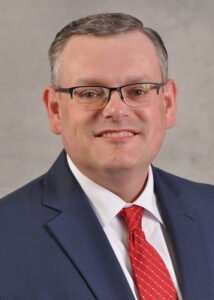By Deborah Jeanne Sergeant
The pandemic exacerbated the longstanding shortage of bedside nurses. Tougher conditions, supply scarcity, employee illnesses and many sicker patients prompted many hospital nurses to quit the profession or move into a non hospital role in nursing. And about 100,000 left nursing in 2021 alone.

“It’s still a struggle,” said Scott Jessie, master’s trained nurse and chief nursing officer at Upstate University Hospital. “We have some acute care beds closed. We are still relying on a large number of travel staff.”
Hospital nursing has seen a good amount of turnover because of the rise of travel nursing, which Jessie said “exploded” during the pandemic. Replacing retiring and quitting nurses isn’t easy. Jessie said that nationwide, schools decline about 90,000 would-be nursing students annually because of lack of faculty.
Some quit for the variety of travel nursing assignments, so Upstate highlights that it offers the most specialties in nursing in the CNY region. Upstate also has “significantly improved” its pay over the past 18 months, Jessie added, admitting that it “wasn’t as competitive” before.
“We have excellent benefits and retirement packages,” Jessie said. “We pay up front for tuition for education: bachelor’s, master’s and doctorate degrees.”
On the hospital floor, efforts to improve the employee experience for nurses includes using robots to aid in mundane tasks and smaller electronic medical record devices so nurses no longer have to roll around a computer on wheels room to room.
“We’re a magnet organization,” Jessie said. “Magnet hospitals have a nurse-friendly culture top down and bottom up. Our staff at the bedside comes up with an awful lot of ideas we in senior leadership wouldn’t.”
Rounding with bedside staff also helps keep leadership in touch with nurses. Upstate’s nurse residency program helps new nurses get on board with mentoring and camaraderie opportunities.
Extending recruitment to Syracuse City Schools from the middle school level upwards raises awareness of nursing as a career option. A greater presence on social media has also helped, with clips of employees sharing why they work at Upstate, or the benefits offered.
Reaching mid-career job changers is another way Upstate seeks to combat the nursing shortage. These potential nursing candidates may already have a bachelor’s degree and qualify for an accelerated program. But they also need more flexibility in the program with evening, weekend and hybrid classes. Jessie said that many who have been in service-oriented careers such as firefighters or the military have shown more interest in nursing in recent years.
Workplace violence has begun to deter people considering nursing as their career—and it’s not coworker to coworker but directed toward nurses by patients and family members.
To reduce this issue, Upstate maintains a police department on-site, screens for weapons at all entry points and operates an employee assistance program to counsel staff on personal and mental health issues.
At VA Medical Center in Syracuse, travelers have also helped fill in the gaps, although Megan Queary, nurse recruiter for VA Medical Center in Syracuse, said that the need is lessening now that the pandemic has subsided. The VA has partially opened one of its med-surg units that was closed during the pandemic.
To reach more potential employees, the VA has been participating in job fairs and tours of their facility.
“We’re reaching out to the community for graduated students,” she said. “We’re and really ‘selling’ what the VA has to offer, like the benefit package and the mission the VA has to take care of America’s heroes. It’s a big selling point. Many people share that value and want to give back.”
The VA has also increased its pay rates and offers tuition reimbursement for nurses.
“Our RNs get five weeks of vacation and two weeks of sick leave that they start accruing once they get here,” Queary said. “The government matches 5% of our retirement. You’re vested after five years. You can take your healthcare and retirement with you.”
Suzanne Talarico, registered nurse and manager of talent acquisition at St. Joseph’s Health, described the capacity at the hospital as “a continuous ebb and flow over the past three years. The leadership is monitoring what’s going on in the community. There has been shifting of units, some that have closed temporarily and reopened. We’re experimenting with a discharge lounge to navigate patients differently.”
This can free up beds for new patients. In addition, the hospital is looking at different staffing models to use licensed staff at their highest scope of practice. Talarico said that virtual nursing may roll out by the end of 2023 to help address healthcare needs that are manageable remotely.
“We’re trying to be creative and flexible and try a variety of tactics,” Talarico said.
“Headhunters” are part of how St. Joseph’s is seeking nursing candidates. The organization seeks to learn about applicants’ goals so they can provide what they want, such as benefits, flexible scheduling, tuition reimbursement and workplace culture. St. Joseph’s is started to look at loan repayment as a benefit.
Drawing from the college also helps attract more nurses for St. Joseph’s, compared with hospitals that do not operate a college. Talarico said that opening up hiring to refugees who want to learn nursing and medical professionals from other countries may prove another means of attracting more talent to St. Joseph’s.
“We’re becoming much more flexible and open to what a potential candidate or hire would want or need and bringing that to our leadership team to vet,” Talarico said.
The organization is looking at adjusting its pay scale to better reflect that of other organizations. Travel nursing has been part of its strategy to address the nursing shortage. However, as the pay rates for travel nurses have come down, fewer people seem interested in this type of employment.
Employee wellness and safety is another benefit that St. Joseph uses to differentiate itself from other hospitals, as well as keeping lines of communication open between leadership and frontline staff.
“The people we call ‘boomerangs’ — we pay attention to why they come back,” Talarico said. “It speaks to our culture and missions. We had so many people who left for many reasons, like family-life balance or for travel nursing. Reaching out to them can help. They missed the culture and the way people worked together and the type of care that we provide. They’re always very happy to come back.”

